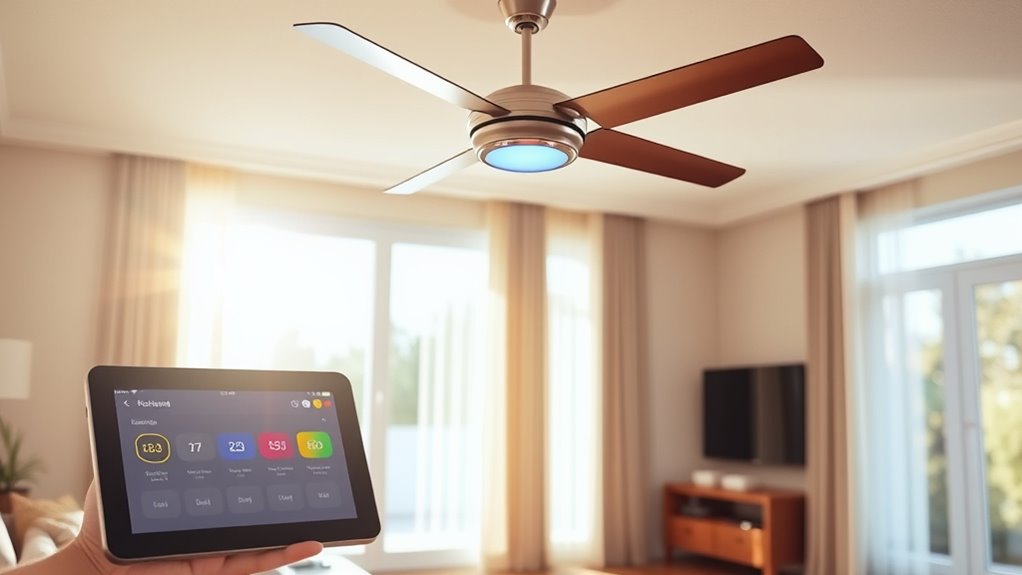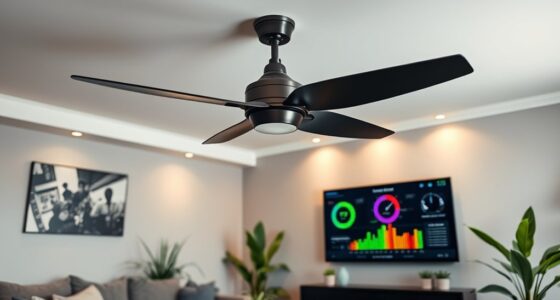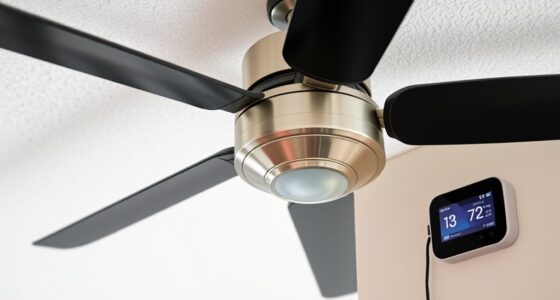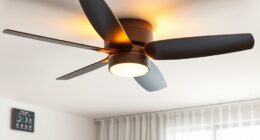To schedule your smart ceiling fan for seasonal changes, you should configure specific operation times and modes based on your local climate and household habits. Utilize the fan’s app or automation platform to set different speeds and reverse direction for summer and winter, automatically adjusting as the seasons shift. Incorporate sensors or weather data for proactive control, optimizing comfort and efficiency. Stay tuned to discover how advanced automation can further enhance your home’s climate management.
Key Takeaways
- Set distinct schedules for summer and winter to optimize fan speed and direction based on seasonal needs.
- Use automation features or apps to switch fan modes automatically with seasonal changes.
- Program higher speeds during warmer months and reverse mode for better heat circulation in colder seasons.
- Incorporate sensors or weather data for proactive adjustments and improved energy efficiency.
- Align fan operation with other climate controls to enhance overall home comfort and reduce energy consumption.
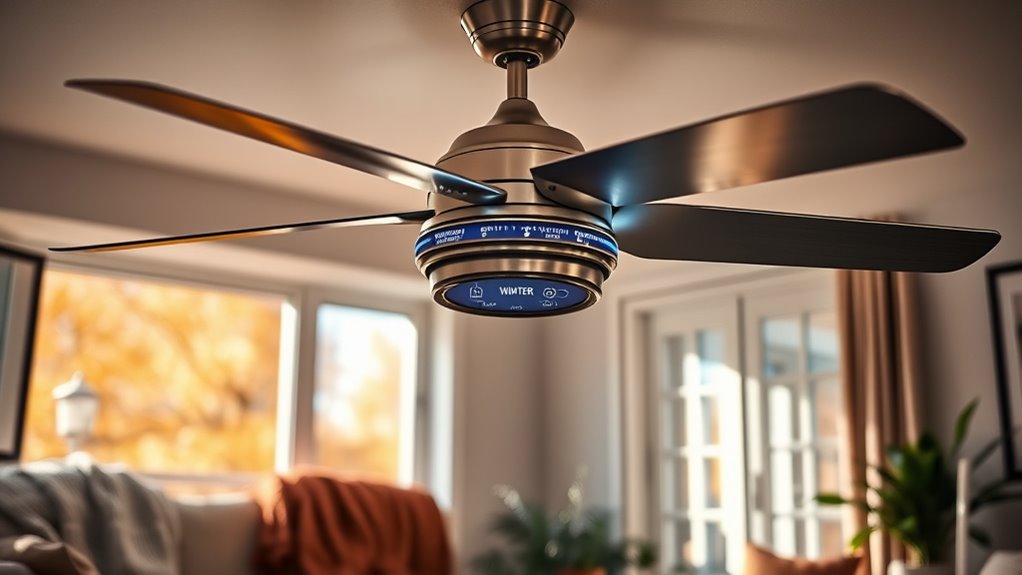
Have you considered how scheduling smart ceiling fans can maximize your comfort and energy efficiency? The ability to program your fan’s operation based on seasonal changes is a critical feature that enhances performance while minimizing energy consumption. By integrating precise scheduling, you guarantee that your fan activates and deactivates at ideal times, aligning with temperature fluctuations and occupancy patterns. This minimizes unnecessary energy use, reducing utility costs and extending the lifespan of the device.
From a technical perspective, seasonal scheduling involves establishing specific timeframes during which the fan operates at designated speeds or directions. In warmer months, configuring your fan to run intermittently or at higher speeds during peak hours helps facilitate air circulation and cooling, thereby reducing reliance on air conditioning. Conversely, during cooler seasons, scheduling the fan to operate in reverse mode at lower speeds can aid in distributing warm air more evenly, preventing cold spots and enhancing heating efficiency. These adjustments require precise input into the fan’s control system, often through dedicated apps or integrated home automation platforms that support seasonal programming.
Seasonal scheduling optimizes fan speeds and directions for year-round comfort and energy savings.
Implementing seasonal schedules requires a detailed understanding of your local climate patterns and your household’s occupancy habits. Many smart fans allow you to set multiple schedules that automatically switch with the seasons, based on date or weather triggers. For example, you can program the fan to start in reverse mode at the onset of fall and switch back to forward mode with the arrival of spring, ensuring ideal airflow direction year-round. This dynamic scheduling eliminates the need for manual adjustments and ensures consistent comfort.
Furthermore, advanced scheduling features enable you to incorporate sensor data, such as temperature or occupancy sensors, to refine operation. When integrated with weather forecasts, these systems can automatically adjust fan operation to preempt temperature changes, providing proactive comfort management. Such automation not only enhances energy savings but also improves overall indoor air quality and comfort levels. Additionally, understanding Volkswagen Tuning principles can inspire you to optimize your home’s climate control efficiency, akin to tuning a vehicle for peak performance, ensuring your smart ceiling fan operates at its best. Precise scheduling also helps avoid overlapping or redundant operation with other climate control devices, ensuring a coordinated approach that maximizes efficiency.
Frequently Asked Questions
Can Smart Fans Detect Outdoor Temperature Changes Automatically?
Smart fans generally can’t automatically detect outdoor temperature changes unless integrated with external sensors or smart home systems. They rely on built-in temperature sensors or app controls to adjust their operation. If you want your smart fan to respond to outdoor conditions, you’ll need to connect it with a compatible weather or home automation system that provides real-time outdoor temperature data, enabling automatic adjustments based on environmental changes.
How Do I Troubleshoot Connectivity Issues With My Smart Ceiling Fan?
You should first check your Wi-Fi connection to verify it’s stable and within range of your fan. Restart your router and reconnect your smart fan via the app. Confirm that your device’s firmware and the fan’s firmware are up-to-date. If issues persist, reset the fan to factory settings and reconfigure it. Verify that your app has necessary permissions and that your network settings allow communication with the device.
Are There Energy-Saving Benefits Specific to Seasonal Scheduling?
Yes, seasonal scheduling enhances energy savings by optimizing fan operation according to outdoor temperatures and daylight hours. During summer, you can set the fan to run during peak heat periods, reducing the load on your air conditioning. In winter, scheduling the fan to run intermittently helps circulate warm air without overuse. This precise control minimizes energy consumption, lowers utility bills, and extends the lifespan of your fan and HVAC system.
Can I Integrate Smart Fan Scheduling With Other Smart Home Devices?
Yes, you can integrate smart fan scheduling with other smart home devices, creating a seamless ecosystem like a symphony conductor coordinating diverse instruments. Use platforms like Apple HomeKit, Google Home, or Amazon Alexa to set routines that synchronize your fan with thermostats, lights, and security systems. This integration enhances energy efficiency and comfort by automating device interactions, ensuring your smart home functions harmoniously according to your schedule and preferences.
What Safety Precautions Should I Follow When Setting up Schedules?
When setting up schedules, guarantee your smart fan is properly installed and connected to a stable power source. Verify that your Wi-Fi network is secure to prevent unauthorized access. Keep the fan’s firmware updated for safety and functionality. Avoid programming schedules during maintenance. Use strong, unique passwords for your smart home system. Test the schedule after setup to confirm it operates correctly, minimizing risk of malfunction or electrical hazards.
Conclusion
By programming your smart ceiling fan to adjust with seasonal changes, you guarantee ideal comfort and energy efficiency. Coincidentally, this synchronization often aligns with natural temperature shifts, maximizing savings without manual intervention. As technology seamlessly integrates with environmental patterns, your setup becomes both intuitive and precise. Ultimately, scheduling smart fans isn’t just automation—it’s a strategic alignment with nature’s rhythms, delivering enhanced performance and sustainability through well-timed adjustments.
